The ASRock Z170 Extreme7+ Review: When You Need Triple M.2 x4 in RAID
by Ian Cutress on November 27, 2015 11:59 AM EST- Posted in
- Motherboards
- ASRock
- M.2
- Skylake
- Z170
System Performance
Not all motherboards are created equal. On the face of it, they should all perform the same and differ only in the functionality they provide - however this is not the case. The obvious pointers are power consumption, but also the ability for the manufacturer to optimize USB speed, audio quality (based on audio codec), POST time and latency. This can come down to manufacturing process and prowess, so these are tested.
Power Consumption
Power consumption was tested on the system while in a single MSI GTX 770 Lightning GPU configuration with a wall meter connected to the OCZ 1250W power supply. This power supply is Gold rated, and as I am in the UK on a 230-240 V supply, leads to ~75% efficiency > 50W, and 90%+ efficiency at 250W, suitable for both idle and multi-GPU loading. This method of power reading allows us to compare the power management of the UEFI and the board to supply components with power under load, and includes typical PSU losses due to efficiency. These are the real world values that consumers may expect from a typical system (minus the monitor) using this motherboard.
While this method for power measurement may not be ideal, and you feel these numbers are not representative due to the high wattage power supply being used (we use the same PSU to remain consistent over a series of reviews, and the fact that some boards on our test bed get tested with three or four high powered GPUs), the important point to take away is the relationship between the numbers. These boards are all under the same conditions, and thus the differences between them should be easy to spot.

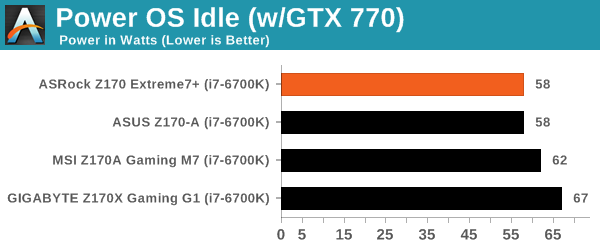
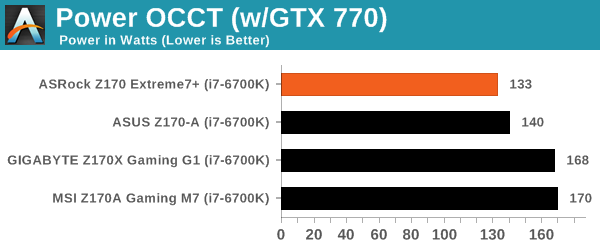
While the ASRock was not strictly the lowest consumer of power at idle, when we look at the idle to load differential, it shows a 73W gain for the i7-6700K, compared to the 110W seen on the MSI. This is in part because we saw a number of the early motherboard BIOSes overestimate the load voltage required at stock, as well as an element of MultiCore Turbo keeping voltages high. But in this case, because the ASRock does not have multicore turbo, it saves power at the wall.
Non UEFI POST Time
Different motherboards have different POST sequences before an operating system is initialized. A lot of this is dependent on the board itself, and POST boot time is determined by the controllers on board (and the sequence of how those extras are organized). As part of our testing, we look at the POST Boot Time using a stopwatch. This is the time from pressing the ON button on the computer to when Windows 7 starts loading. (We discount Windows loading as it is highly variable given Windows specific features.)
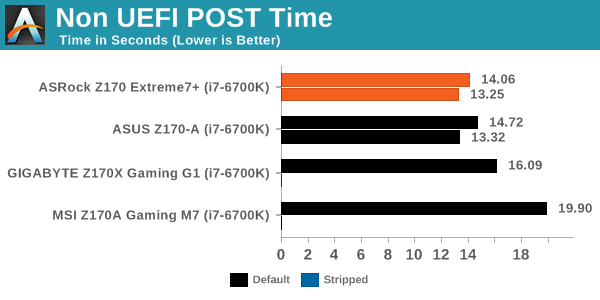
Because this is still early days for the Z170 platform, POST times are seemingly all over the place as motherboard manufacturers optimize their boot routines. Nevertheless, the ASRock comes out on top in its default setting, over the ASUS, GIGABYTE and way ahead of the MSI.
Rightmark Audio Analyzer 6.2.5
Rightmark:AA indicates how well the sound system is built and isolated from electrical interference (either internally or externally). For this test we connect the Line Out to the Line In using a short six inch 3.5mm to 3.5mm high-quality jack, turn the OS speaker volume to 100%, and run the Rightmark default test suite at 192 kHz, 24-bit. The OS is tuned to 192 kHz/24-bit input and output, and the Line-In volume is adjusted until we have the best RMAA value in the mini-pretest. We look specifically at the Dynamic Range of the audio codec used on board, as well as the Total Harmonic Distortion + Noise.

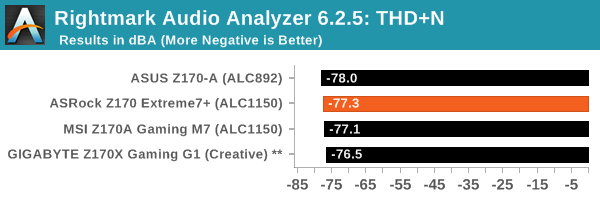
Using the ALC1150 and an improved design should put the ASRock implementation near the top for audio, and the -103 dBA result for SNR shows it.
USB Backup
For this benchmark, we transfer a set size of files from the SSD to the USB drive using DiskBench, which monitors the time taken to transfer. The files transferred are a 1.52 GB set of 2867 files across 320 folders – 95% of these files are small typical website files, and the rest (90% of the size) are small 30 second HD videos. In an update to pre-Z87 testing, we also run MaxCPU to load up one of the threads during the test which improves general performance up to 15% by causing all the internal pathways to run at full speed.
Due to the introduction of USB 3.1, as of June 2015 we are adjusting our test to use a dual mSATA USB 3.1 Type-C device which should be capable of saturating both USB 3.0 and USB 3.1 connections. We still use the same data set as before, but now use the new device. Results are shown as seconds taken to complete the data transfer.
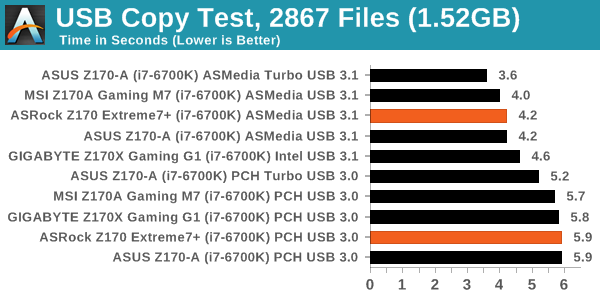
Like most of the USB 3.1 enabled motherboards on launch day, the ASMedia controller for the USB ports performs well although there does seem to see some variation in results as this is also optimized in firmware and drivers.
DPC Latency
Deferred Procedure Call latency is a way in which Windows handles interrupt servicing. In order to wait for a processor to acknowledge the request, the system will queue all interrupt requests by priority. Critical interrupts will be handled as soon as possible, whereas lesser priority requests such as audio will be further down the line. If the audio device requires data, it will have to wait until the request is processed before the buffer is filled.
If the device drivers of higher priority components in a system are poorly implemented, this can cause delays in request scheduling and process time. This can lead to an empty audio buffer and characteristic audible pauses, pops and clicks. The DPC latency checker measures how much time is taken processing DPCs from driver invocation. The lower the value will result in better audio transfer at smaller buffer sizes. Results are measured in microseconds.

For whatever reason, our DPC result came back rather poorly here. We’re not sure if it’s just a BIOS not set up for DPC Latency, or something more fundamental. As time goes on and the platform matures, we’ll see more motherboards underneath 100.










63 Comments
View All Comments
Idrathernotsay - Friday, November 27, 2015 - link
Dunno about the actual quality of the motherboard, but Newegg has, for example, an MSI board for $89, with USB 3.1, m.2 slot (PCIe 3.0 x4), and Realtek audio/network. I'd just like to know if a fancy network card can justify 2x the price, or if the bottom-of-the-barrel motherboards are made of literal garbage and will burst in flames if you look at them the wrong way, because, -for me specifically-, a network card just has to be there and the audio is useless (as I've a xonar for my headphones).Are there actually any stability issues with the cheaper motherboards? Weaker power delivery circuitry that limits the possible overclocks— if so, by how much? $80 dollars can be quite a bit, and either saving or spending them somewhere else on the machine might make a bigger difference than going for a pricier mobo...
Aspiring Techie - Friday, November 27, 2015 - link
The cheaper motherboards probably can't handle much of an i5 overclock. However, I own a $60 Asrock H81m DGS board, and I can maintain a stable 4.0 GHz at low temps with the stock cooler. Cheaper motherboards don't have as elaborate vrm cooling solutions, so high overclocks can bust the board. However, cheaper boards will do roughly the same as a more expensive board as long as you aren't running a PCIe SSD or a very high end graphics card with an overclocked i7.Idrathernotsay - Friday, November 27, 2015 - link
Fine, but that's a bit vague tho. The "problem" with the cheaper end of the spectrum is that you have to rely on word of mouth, or occasional reviews on stores, that might or might not actually apply to the motherboard you're considering. How does "probably can't handle much of an overclock" translate in numbers? It's obviously gonna run stock (or they wouldn't sell it), and it —does— support overclock, but how would that be affected by the power delivery with the specific Skylake architecture? If it runs 4.6 fine, I (and a bajillion other people) would be perfectly fine with that while putting $80 more onto the GPU (or back in my wallet).I'm not asking for an in-depth review (as there's not much point in a feature-light product, when the general architecture of the platform has already been analyzed in details), but I just wonder how useful reviewing pieces of hardware that are full of "gimmicks" and targeted to the smallest of niches (as the article itself states in the conclusion), and not even give a quick glance to the bottom-tier that actually moves the most units.
I'm not saying that any of the writers here —have— to, or that the reviews that are currently published aren't interesting, just that I'd like to see some Anandtech-quality numbers of shit I might actually buy. They do test cheaper SSDs and the less expensive GPUs, less pricey mobos wouldn't be that far out.
alexdi - Saturday, November 28, 2015 - link
There isn't any significant difference. You'll have fewer PCIe lanes, fewer third-party chips, and somewhat simplified voltage regulation. That stuff will matter for some edge cases and not at all for everyone else. Otherwise, IME, the manufacturer of the board is considerably more important than what it has on it. They apply the same QC, good or bad, to L the boards.JlHADJOE - Friday, November 27, 2015 - link
OC software is getting really good. In this case it looks like it actually outdid your manual OC, getting 4.7GHz stable at lower voltage and temps.extide - Monday, November 30, 2015 - link
x2, I was surprised that this was not mentioned in the article!!rallyhard - Friday, November 27, 2015 - link
The "Conclusions" link, under "Quick Links to Other Pages" actually links to page 1.Ian Cutress - Friday, November 27, 2015 - link
I'm not sure why that is. The link should work as it was.I've updated it now to include the slug, and it seems to be fixed.
Thanks for letting us know :)
ghostmuse - Friday, November 27, 2015 - link
Man, that is a bummer about the DPC latency. As someone who does a lot of pro audio work, which requires the lowest possible DPC latency, and someone who wants to build an enthusiast system for 4k gaming, Skylake thusfar is not letting me have my cake and eat it too. I was looking at this board because it looked like you'd be able to run Dual SLI and still use one of the M.2 ports, AND was hoping the DPC latency would be low, but that looks like that's not the case. My first choice, ASUS' Z170 Deluxe scored well on the DPC latency tests but if you try to use SLI you block the M.2 port. I guess I'll just save my cash until some next gen boards pop up, or hope that ASROCK manage to get that DPC latency figure down with bios updates.Byte - Saturday, November 28, 2015 - link
I just got one of these puppies running the past week and its awesome. I just got the latest BIOS update, is there an accurate way to measure DPC latency in Win10?